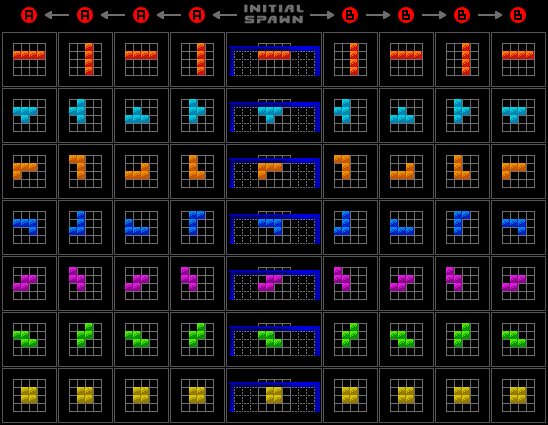Arika Rotation System
'工控机 茅台酒 二锅头 防伪标签 热转印机 水晶像 奖杯 干洗 数码快印 硒鼓加粉 塑料颗粒机 防伪 防伪技术 高新技术企业认定 北京洗衣公司 服务器机柜 空气净化工程 国际速递 国际快递公司 国际快递 梯具 节能节电 冬令营 石材翻新 电器维修 北京公司注册 制冰机 电脑回收 代开发票 不干胶 机打发票 电缆桥架 电缆桥架 北京货架 航空货运 会议服务 小升初 梅兰日兰UPS 口语 Dell服务器 再生塑料颗粒机 灯光音响 二手电脑回收 热水器维修 环氧地坪 IBM服务器 工商注册 IBM服务器 北京航空货运 北京写字楼 动画制作
TGM rotation' is a game play mechanic used in Tetris The Grand Master and other Arika tetromino games, derived from Sega rotation. It is often refered to as ARS (Arika Rotation System), even though some people believe that this name is misleading.
Games using TGM rotation generally use IRS, fast DAS, lock delay, and firm drop, and tetrominoes start out with the topmost block on the top row (generally row 20). The "ARS" and "ARS2" modes of Tetris The Grand Master Ace use a hybrid of TGM rules and Guideline rules.
Basic rotation
TGM's basic rotations inherits most of its properties from Sega rotation, which was used in most previous Japanese arcade Tetris games. Some defining characteristics include:
- Having 2 (as opposed to 4) rotation states for S, Z, and I tetrominoess, which simplifies learning.
- Keeping tetrominoes at an even level while rotating to always allow rotation when the tetromino is on a flat surface (except for the I tetromino - see exceptions below).
- Pointing the initial stance of the T, L, and J tetrominoes downward, which adds some extra challenge and also makes it easier for tetrominoes to grab bumps along the surface of the stack when playing at high gravity.

Wall kicks
TGM pioneered the use of wall kicks, with simple but effective kick rules. These rules were unchanged until TGM3, remaining constant across TGM, TA, TAP, and Sakura Tetris. Up to 3 locations are tried, in this order, before rotation will fail:
- Basic rotation
- 1 space right of basic rotation
- 1 space left of basic rotation
In addition to these rules, there are some extra exceptions where certain wall kicks are not allowed:
- The I tetromino will never kick.
- L, J, and T tetrominoes will not rotate in the situations illustrated below if the
 marked block is occupied.
marked block is occupied.
|
|
| ||
|
|
| ||
|
|
- However, L tetrominoes will rotate clockwise and J tetrominoes counterclockwise in the situations illustrated below if both the
 marked blocks are occupied.
marked blocks are occupied.
|
|
New wall kicks in TGM3
I tetromino's wall kicks
In TGM3, the I tetromino can kick walls. There are 3 different types of wall kicks.
|
Try to rotate |
Basic rotation fails |
Kick 1 space right | |||
|
Try to rotate |
Basic rotation fails |
Kick 2 space right | |||
|
Try to rotate |
Basic rotation fails |
Kick left |
I tetromino's floor kicks
The I tetromino can kick the floor.
Notes:
- Like hold piece, floor kick can be performed only once per tetromino.
- This action causes lock delay reset.
- The tetromino cannot kick the floor in mid-air.
|
Fail |
OK |
OK |
There are 2 different types of floor kicks.
|
Try to rotate |
Basic rotation fails |
Kick 1 space up | |||
|
Try to rotate |
Basic rotation fails |
Kick 2 space up |
T tetromino's floor kicks
The T tetromino can escape from a hollow.
Notes:
- This action can be performed only once per tetromino.
- This action causes lock delay reset.
|
Try to rotate |
Basic rotation fails |
Kick up |
To-Do
- describe ACE's ARS and ARS2
- describe "Mihara's conspiracy"
- mention right bias
- add more visual aids?